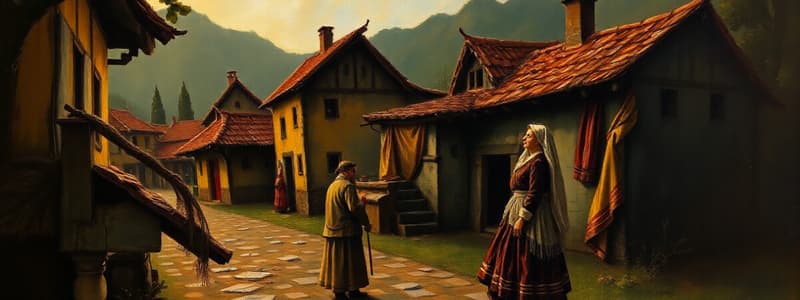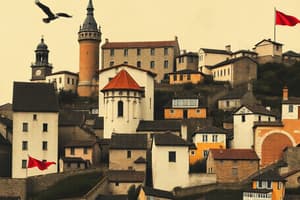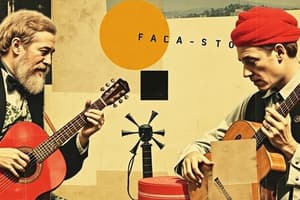Podcast
Questions and Answers
¿Qué elemento del patrimonio inmaterial asturiano combina música tradicional y rito religioso?
¿Qué elemento del patrimonio inmaterial asturiano combina música tradicional y rito religioso?
- La Misa Asturiana de Gaita (correct)
- El juego de los bolos asturianos
- La jota asturiana
- La danza del Corri-Corri
¿Qué técnica constructiva fue reconocida por la UNESCO en 2018?
¿Qué técnica constructiva fue reconocida por la UNESCO en 2018?
- La construcción en ladrillo
- La construcción en madera
- La construcción en adobe
- La construcción en piedra seca (correct)
¿Qué instrumento musical es parte de la Misa Asturiana de Gaita?
¿Qué instrumento musical es parte de la Misa Asturiana de Gaita?
- La flauta
- El tambor
- La gaita (correct)
- El acordeón
¿Cuál de las siguientes manifestaciones culturales no se incluye en el Censo del Patrimonio Cultural Inmaterial de Asturias?
¿Cuál de las siguientes manifestaciones culturales no se incluye en el Censo del Patrimonio Cultural Inmaterial de Asturias?
¿Qué estilo vocal es característico de Asturias?
¿Qué estilo vocal es característico de Asturias?
¿Cuál de esto es un ejemplo de patrimonio cultural inmaterial relacionado con la sidra?
¿Cuál de esto es un ejemplo de patrimonio cultural inmaterial relacionado con la sidra?
¿Qué región en Asturias es conocida por su 'manta candasina'?
¿Qué región en Asturias es conocida por su 'manta candasina'?
¿Qué festividad local es relevante en la cultura asturiana?
¿Qué festividad local es relevante en la cultura asturiana?
¿Qué aspecto de la cultura asturiana se refleja en los trajes típicos aldeanos?
¿Qué aspecto de la cultura asturiana se refleja en los trajes típicos aldeanos?
¿Qué instrumento musical es especialmente destacado en el área musical del museo?
¿Qué instrumento musical es especialmente destacado en el área musical del museo?
¿Qué elementos no forman parte del patrimonio cultural inmaterial registrado en Asturias?
¿Qué elementos no forman parte del patrimonio cultural inmaterial registrado en Asturias?
¿Cuál de las siguientes actividades educativas aborda la vida rural de antaño?
¿Cuál de las siguientes actividades educativas aborda la vida rural de antaño?
¿Qué tipo de tecnología se utiliza para acceder a más de un millón de fotografías en el museo?
¿Qué tipo de tecnología se utiliza para acceder a más de un millón de fotografías en el museo?
¿Qué área del museo incluye archivos de correspondencia y documentos empresariales?
¿Qué área del museo incluye archivos de correspondencia y documentos empresariales?
¿Cuál de las siguientes afirmaciones es correcta sobre la fonoteca del museo?
¿Cuál de las siguientes afirmaciones es correcta sobre la fonoteca del museo?
¿Qué aspecto de la cultura asturiana se enfatiza en el taller 'Asturias, un mundo de madera'?
¿Qué aspecto de la cultura asturiana se enfatiza en el taller 'Asturias, un mundo de madera'?
¿Qué actividad involucra la expresión rítmica y corporal a través del folclore asturiano?
¿Qué actividad involucra la expresión rítmica y corporal a través del folclore asturiano?
¿Cuál es el propósito del programa educativo del Museo del Pueblu d’Asturies?
¿Cuál es el propósito del programa educativo del Museo del Pueblu d’Asturies?
¿Qué tipo de materiales se emplean en el taller 'Aprendiendo a tejer'?
¿Qué tipo de materiales se emplean en el taller 'Aprendiendo a tejer'?
¿Desde qué periodo documenta la fototeca la vida en Asturias?
¿Desde qué periodo documenta la fototeca la vida en Asturias?
¿Cuál es el propósito principal del Archivo de la Música Tradicional en Asturias?
¿Cuál es el propósito principal del Archivo de la Música Tradicional en Asturias?
¿Qué aspecto destaca como clave en la preservación del patrimonio inmaterial en Asturias?
¿Qué aspecto destaca como clave en la preservación del patrimonio inmaterial en Asturias?
El Atlas Sonoru de la Llingua Asturiana tiene como función principal:
El Atlas Sonoru de la Llingua Asturiana tiene como función principal:
¿Qué año se estableció la Red de Museos Etnográficos de Asturias?
¿Qué año se estableció la Red de Museos Etnográficos de Asturias?
¿Qué tipo de patrimonio se enfoca principalmente la Red de Museos Etnográficos de Asturias?
¿Qué tipo de patrimonio se enfoca principalmente la Red de Museos Etnográficos de Asturias?
¿Qué museo mencionado se especializa en la producción de sidra?
¿Qué museo mencionado se especializa en la producción de sidra?
La Red de Museos Etnográficos incluye varios museos. ¿Cuál de los siguientes no es parte de esta red?
La Red de Museos Etnográficos incluye varios museos. ¿Cuál de los siguientes no es parte de esta red?
¿Qué concepto describe mejor la conservación de las colecciones en los museos mencionados?
¿Qué concepto describe mejor la conservación de las colecciones en los museos mencionados?
¿Cómo contribuye el Atlas Sonoru a la cultura asturiana?
¿Cómo contribuye el Atlas Sonoru a la cultura asturiana?
¿Cuál de las siguientes afirmaciones sobre la música tradicional asturiana es correcta?
¿Cuál de las siguientes afirmaciones sobre la música tradicional asturiana es correcta?
Flashcards
Patrimonio Cultural Inmaterial
Patrimonio Cultural Inmaterial
Conocimientos, prácticas, y usos tradicionales que son importantes para la cultura de una región.
Ley 10/2015
Ley 10/2015
Ley española que protege el Patrimonio Cultural Inmaterial a nivel nacional.
Censo del Patrimonio Cultural Inmaterial de Asturias
Censo del Patrimonio Cultural Inmaterial de Asturias
Registro de las manifestaciones culturales de Asturias, para la conservación y difusión.
Misa Asturiana de Gaita
Misa Asturiana de Gaita
Signup and view all the flashcards
Cultura de la sidra
Cultura de la sidra
Signup and view all the flashcards
Asturianada
Asturianada
Signup and view all the flashcards
Bolos asturianos
Bolos asturianos
Signup and view all the flashcards
Técnica de construcción en piedra seca
Técnica de construcción en piedra seca
Signup and view all the flashcards
Manta Candasina
Manta Candasina
Signup and view all the flashcards
Jota Asturiana
Jota Asturiana
Signup and view all the flashcards
Patrimonio Inmaterial de Asturias
Patrimonio Inmaterial de Asturias
Signup and view all the flashcards
Difusión del Patrimonio Inmaterial
Difusión del Patrimonio Inmaterial
Signup and view all the flashcards
Red de Museos Etnográficos de Asturias
Red de Museos Etnográficos de Asturias
Signup and view all the flashcards
Conservación de objetos
Conservación de objetos
Signup and view all the flashcards
Archivo de la Música Tradicional
Archivo de la Música Tradicional
Signup and view all the flashcards
Atlas Sonoro de la Llingua Asturiana
Atlas Sonoro de la Llingua Asturiana
Signup and view all the flashcards
Museos Etnográficos
Museos Etnográficos
Signup and view all the flashcards
Preservación cultural
Preservación cultural
Signup and view all the flashcards
Colecciones representativas
Colecciones representativas
Signup and view all the flashcards
Patrimonio Etnográfico
Patrimonio Etnográfico
Signup and view all the flashcards
Museo del Pueblo de Asturias
Museo del Pueblo de Asturias
Signup and view all the flashcards
Área de objetos cotidianos (siglos XIX y XX)
Área de objetos cotidianos (siglos XIX y XX)
Signup and view all the flashcards
Área Musical
Área Musical
Signup and view all the flashcards
Fototeca del museo
Fototeca del museo
Signup and view all the flashcards
Área de Documentación
Área de Documentación
Signup and view all the flashcards
Programas educativos del museo
Programas educativos del museo
Signup and view all the flashcards
Exploración del entorno natural y cultural
Exploración del entorno natural y cultural
Signup and view all the flashcards
Introducción a la música y folclore asturiano
Introducción a la música y folclore asturiano
Signup and view all the flashcards
Historia y vida rural
Historia y vida rural
Signup and view all the flashcards
Artesanía y materiales locales
Artesanía y materiales locales
Signup and view all the flashcards
Study Notes
Patrimonio Inmaterial de Asturias
- Asturias's intangible cultural heritage encompasses a diverse range of knowledge, techniques, and cultural expressions passed down through generations.
- These elements are fundamental to Asturian identity, reflecting the adaptation of local communities to their environment and history.
- Intangible heritage differs from tangible heritage (buildings, monuments), consisting of intangible knowledge, skills, and practices embedded in memory and experience. This forms the ethos of the culture.
- Intangible heritage is crucial for strengthening a sense of belonging and respect for cultural diversity and creativity.
Types of Intangible Heritage
- Traditional music and dances
- Traditional crafts techniques
- Festivals
- Gastronomy
- Language
- Rituals
Asturian Heritage Law
- The Asturian Cultural Heritage Law (2001) provides a comprehensive legal framework for protecting cultural expressions.
- This law supports documentation and research on intangible heritage.
- The law promotes both community and academic conservation efforts.
Examples of Asturian Intangible Heritage
- Asturian gaita music, combining traditional music with religious ceremony.
- Sidra production and consumption practices
- "Asturianada" (a unique local vocal style)
- Traditional Asturian games (e.g., bolos)
- Traditional clothing styles
- Stone construction techniques
Legislation and Protection
- The Asturian Cultural Heritage Law protects both tangible and intangible heritage.
- Specific mechanisms for identifying, conserving, and promoting intangible heritage are in place.
- Spain's adherence to the UNESCO Convention for the Safeguarding of Intangible Cultural Heritage (2006), and the 2015 Spanish Heritage Law strengthen this protection.
- The Asturian Intangible Cultural Heritage Inventory acts as a register of cultural practices.
Materials, Collection, and Conservation
- The conservation of Asturias' intangible heritage requires specific methods for gathering, documenting, and preserving intangible cultural expressions.
- Sound recordings, audiovisual documents, and craft objects are vital materials.
- These materials document knowledge, skills, and traditions.
Museum of the Asturian People (Muséu del Pueblu d'Asturies)
- It is a key institution for preserving, studying, and promoting Asturian cultural heritage.
- Displays traditional Asturian buildings (homes, barns, storehouses).
- Houses a collection of traditional Asturian musical instruments and recordings.
- Exhibits documentation of daily life, crafts, and rituals.
- Offers educational programs.
- Organized in four main thematic areas:
- Geographical area: Objects of daily life from the 19th and 20th centuries, including household items, farming tools, and religious items.
- Music area: Instruments and recordings of traditional Asturian music.
- Photography area: A vast collection of photographs and postcards documenting Asturian life from the late 19th century to the year 2000.
- Documentation area: Archives of correspondence, business documents, graphic material, maps and an anthropology library.
Network of Asturian Ethnographic Museums
- Created to coordinate the management, conservation, and research into Asturian ethnographic heritage.
- Includes various specialized museums across Asturias, providing a comprehensive view of Asturian culture.
- Dedicated educational projects connect museums with schools promoting learning through activities and practical demonstrations.
- Fosters community engagement and knowledge sharing.
Dissemination of Intangible Heritage
- The dissemination (sharing) of intangible heritage is key to preserving it.
- The "Fontes Sonores" collection makes traditional recordings widely available to the public and scholars.
- Other initiatives include the "Atlas Sonoru" (sound atlas), providing access to Asturian language recordings.
- Museums play a critical role in sharing information and promoting understanding of intangible heritage.
Studying That Suits You
Use AI to generate personalized quizzes and flashcards to suit your learning preferences.



